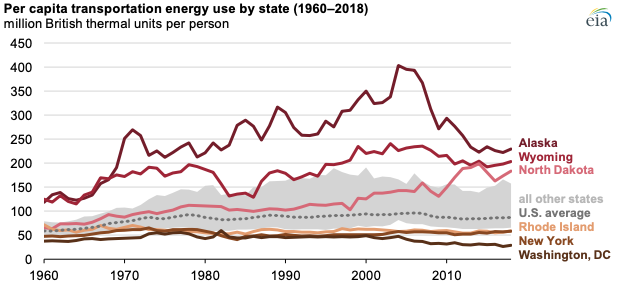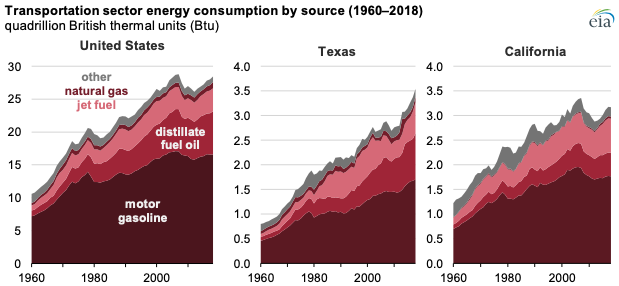More energy is used per person for transportation in states with low population density
Aug 31, 2020According to the latest data estimates in the U.S. Energy Information Administration’s (EIA) State Energy Data System (SEDS), people in geographically large states with small populations, such as Alaska, Wyoming, and North Dakota, used twice as much energy for transportation than the U.S. average on a per capita basis. States with higher population density, such as Rhode Island and New York, used less transportation energy per capita in 2018.

EIA estimates annual energy consumption by state, source, and sector using EIA surveys and third-party data sources. EIA converts these energy data, usually collected in physical units such as gallons, cubic feet, and kilowatthours, to common energy units (British thermal units) for comparison among energy sources and sectors. In 2018, energy consumption for transportation in the United States averaged 87 million British thermal units (Btu) per person.
Transportation sector consumption estimates include all energy used by automobiles, trains, aircraft, ships, and other vehicles whose primary purpose is to transport people or goods, or both, from one place to another. Vehicles that are used for construction, for farming, and in warehouses are included in the commercial or industrial sectors.
Alaska, which has the smallest population density of any state, has ranked as the state with the highest level of per capita transportation energy consumption in every year since 1969. In 2018, significantly more jet fuel per capita was consumed in Alaska than in any other state, at 135 million Btu, or about 1,002 gallons—almost 13 times the U.S. average of 80 gallons. Located about 500 miles north of the contiguous United States, Alaska is a major fueling stop for military aircraft as well as for commercial passenger and cargo flights between the United States and Asia.
Transportation sector per capita consumption of distillate fuel oil in Wyoming was 102 million Btu, or about 742 gallons, in 2018. Wyoming has the smallest population and the highest vehicle miles traveled per capita of any state in the United States. Wyoming and North Dakota also had the highest consumption of motor gasoline per capita, each averaging 66 million Btu, or about 552 gallons, in 2018. North Dakota, a large natural gas-producing state, had the highest consumption of natural gas per capita in the transportation sector, which includes natural gas used for pipeline movements, with 29 million Btu, or about 27,000 cubic feet, in 2018.
In 2018, New York had the lowest per capita transportation energy consumption of any state at 58 million Btu. Only Washington, DC, was lower at 29 million Btu. This result is almost entirely attributable to New York’s low motor gasoline consumption per capita. In 2018, 34 million Btu (284 gallons) and 20 million Btu (164 gallons) of motor gasoline were consumed per capita in New York and Washington, DC, respectively, compared with the U.S. average of 51 million Btu (422 gallons). The low transportation energy consumption in Washington, DC, also reflects that each of the three airports in the district’s metropolitan area are in either Virginia or Maryland.

On an absolute basis (not per capita), the transportation sector in Texas has consumed the most energy of any state since 2013, when it surpassed California. In 2018, 3.5 quadrillion Btu was consumed in Texas’s transportation sector, or about 12% of the nation’s total, and 3.2 quadrillion Btu (11%) was consumed in California. About twice as much distillate fuel oil (diesel) was consumed in Texas than in California, but more motor gasoline and jet fuel was consumed in California than in Texas or any other state.
Principal contributor: Mickey Francis
Similar Stories

Paired Power installs two PairTree solar EV chargers at the Port of Hueneme
View Article
KR, HD KSOE, HD HHI, KSS Line, and Liberian Registry partner to develop safety guidelines for ship-to-ship ammonia bunkering
View Article
U.S. associated natural gas production increased nearly 8% in 2023
View ArticleEIA expects decreasing refining capacity to slow the decline of U.S. refining margins
The U.S. Energy Information Administration (EIA) expects U.S. refinery capacity to be 17.9 million barrels per day by the end of 2025, about 3% less than at the beginning of…
View Article
SAFEEN Group’s fully electric Damen RSD-E Tug 2513 achieves Guinness World Record™️
View Article
WorldACD Weekly Air Cargo Trends (week 44) - 2024
View ArticleGet the most up-to-date trending news!
SubscribeIndustry updates and weekly newsletter direct to your inbox!





